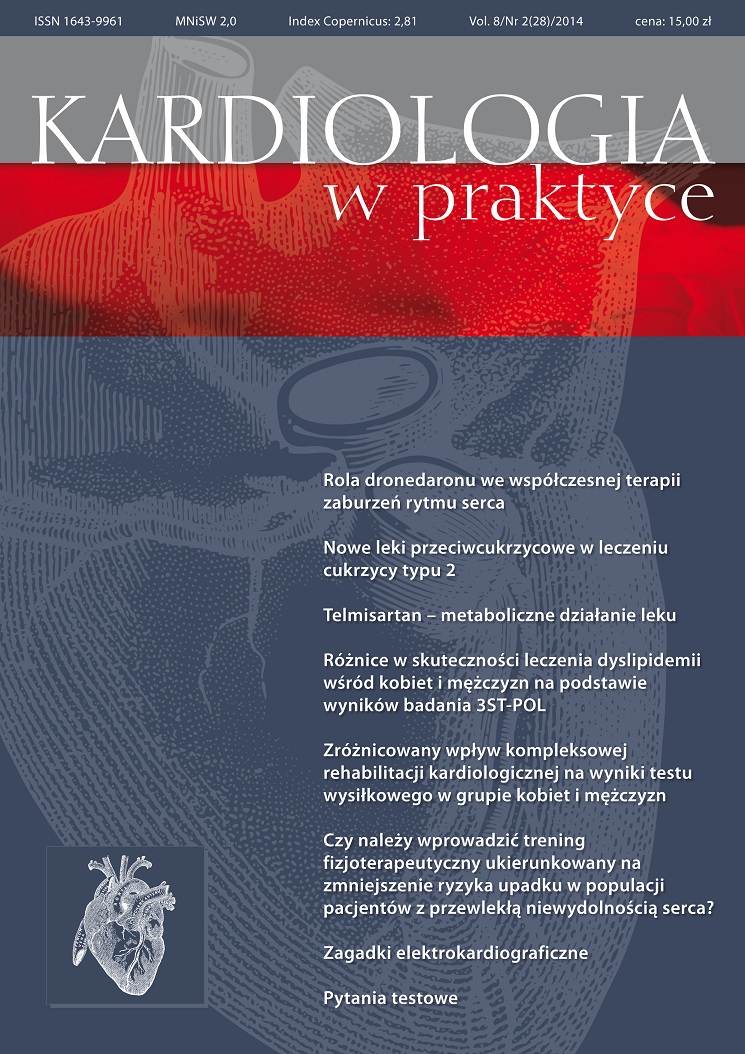Differences in the effectiveness of dyslipidemia treatment among women and men according to the results of 3ST-POL study Original article
Main Article Content
Abstract
Background: Statins play an important role in a modern cardiological pharmacotherapy. For the patient, as a beneficent of an effective pharmacotherapy the most important is, that his or her doctor can take advantage of capability of administered drugs.
Aims: Comparison of the statin treatment effectiveness among women and men enrolled in 3ST-POL study.
Methods: The study tested 49950 (F: 53%; M: 47%) ambulatory patients from Poland. The questionnaire consisted of 43 questions and was filled out by a doctor, based on the results of physical examination, medical record and results of lipid profile determination as well as additional tests.
Results: Only in terms of TC in burdened patients were observed significant differences in efficacy of treatment between the two genders (TC F: 9,32 vs M: 10,28; p = 0,033; LDL F: 15,76 vs M: 15,42; p > 0,05) (TC F: 15,67 vs M: 16,13; p > 0,05; LDL F: 22,99 vs M: 22,29; p = 0,056).
Conclusion: Results of the 3ST-POL study revealed the similar effectiveness of treatment of dyslipidemia, both=
women and men.
Downloads
Article Details

This work is licensed under a Creative Commons Attribution-NonCommercial-NoDerivatives 4.0 International License.
Copyright: © Medical Education sp. z o.o. This is an Open Access article distributed under the terms of the Attribution-NonCommercial 4.0 International (CC BY-NC 4.0). License (https://creativecommons.org/licenses/by-nc/4.0/), allowing third parties to copy and redistribute the material in any medium or format and to remix, transform, and build upon the material, provided the original work is properly cited and states its license.
Address reprint requests to: Medical Education, Marcin Kuźma (marcin.kuzma@mededu.pl)
References
2. Śliż D., Filipiak K.J., Naruszewicz M., Siebert J., Mamcarz A.: Standards of statin usage in Poland in high-risk patients: 3ST-POL study results. Kardiol. Pol. 2013; 71(3): 253-259.
3. Śliż D., Mamcarz A., Filipiak K.J., Siebert J., Naruszewicz M.: 3ST-POL trial: standards of statin use in Poland in the context of the European Society of Cardiology guidelines. Pol. Arch. Med. Wewn. 2010; 120(9): 328-333.
4. Phataka H., Wentworthb C., Sazonova V., Burkea T.: Prevalence and predictors of lipid abnormalities in patients treated with statins in the UK general practice. Atherosclerosis 2009; 202: 225-233.
5. Strang A.C., Kaasjager H.A.H., Basart D.C.G. et al.: Prevelence of dyslipidemia in patients treated with lipid-modifying drugs in the Netherlands. Neth. J. Med. 2010; 68(4): 168-174.
6. Kotseva K., Wood D., De Backer G. et al.: EUROASPIRE III: a survey on the lifestyle, risk factors and use of cardioprotective drug therapies in coronary patients from 22 European countries. J. Cardiovasc. Risk 2009; 16: 121.
7. Yusuf S., Hawken S., Ounpuu S. et al.; INTERHEART Study Investigators: Effect of potentially modifiable risk factors associated with myocardial infarction in 52 countries (the INTERHEART study): case – control study. Lancet 2004; 364(9438): 937-952.
8. Pietrasik A., Starczewska M.E., Główczyńska R. et al.: Leczenie choroby wieńcowej – polska rzeczywistość w świetle wyników badania POLKARD- -SPOK. Przegl. Lek. 2005; 6: 52-57.

